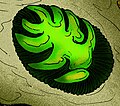Sprigginidae
| Sprigginidae Temporal range: Ediacaran | |
|---|---|

| |
| Spriggina floundersi | |
| Scientific classification | |
| Domain: | Eukaryota |
| Kingdom: | Animalia |
| Phylum: | †Proarticulata |
| Class: | †Cephalozoa |
| Family: | †Sprigginidae Ivantsov, 1999 |
| Type species | |
| †Spriggina floundersi Glaessner, 1958 | |
| Genera | |
|
See text | |
Sprigginidae is an extinct family of cephalozoans characterized by having a greater number of isomers than its sister taxon, Yorgiidae. They lived approximately 635 million years ago, in the Ediacaran period.
Distribution
Fossils are found within the Ediacaran sediments of South Australia.[1]
Taxonomy
Sprigginidae presents 4 genera:
- †Spriggina[2] (type genus).
- †Marywadea
- †Cyanorus
- †Praecambridium, sometimes included into Yorgiidae.
Gallery
- Spriggina floundersi
- Cyanorus singularis
- Praecambridium sigillum
See also
References
- ^ Glaessner, Martin F. (1958). "New Fossils from the Base of the Cambrian in South Australia" (PDF). Transactions of the Royal Society of South Australia. 81: 185–188. BHL page 41001421. Archived from the original (PDF) on 29 September 2007.
- ^ De, C (2005). "Ediacara fossil assemblage in the upper Vindhyans of Central India and its significance". Journal of Asian Earth Sciences. 27 (5): 660–683. doi:10.1016/j.jseaes.2005.06.006.



